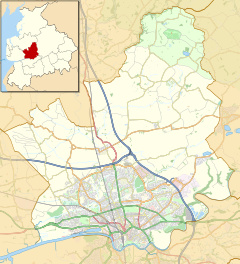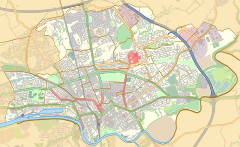
Back Preston Afrikaans Preston AN برستون Arabic برستون ARZ Preston AST Preston Azerbaijani پرستون (لانکاشیر) AZB Прэстан Byelorussian Прэстан BE-X-OLD Престън Bulgarian
| Preston | |
|---|---|
| City | |
| |
 The city flag | |
Location within Lancashire | |
| Population | 147,800 2021[1] |
| Demonym | Prestonian |
| District | |
| Shire county | |
| Region | |
| Country | England |
| Sovereign state | United Kingdom |
| Post town | PRESTON |
| Postcode district | PR1-PR2 |
| Dialling code | 01772 |
| Police | Lancashire |
| Fire | Lancashire |
| Ambulance | North West |
| UK Parliament | |
Preston (/ˈprɛstən/ ) is a city[a] on the north bank of the River Ribble in Lancashire, England. The city is the administrative centre of the county of Lancashire and the wider City of Preston local government district. Preston and its surrounding district obtained city status in 2002, becoming England's 50th city in the 50th year of Queen Elizabeth II's reign.[2] Preston has a population of 114,300,[citation needed] the City of Preston district 132,000[3] and the Preston Built-up Area 313,322.[4] The Preston Travel To Work Area, in 2011, had a population of 420,661,[5] compared with 354,000 in the previous census. The south bank of the Ribble is part of the Preston urban area, although it forms the South Ribble borough that is administratively separate.
Preston and its surrounding area have provided evidence of ancient Roman activity, largely in the form of a Roman road that led to a camp at Walton-le-Dale. The Angles established Preston; its name is derived from the Old English meaning "priest's settlement" and in the Domesday Book is recorded as "Prestune". In the Middle Ages, Preston was a parish and township in the hundred of Amounderness and was granted a Guild Merchant charter in 1179, giving it the status of a market town. Textiles have been produced since the mid-13th century when locally produced wool was woven in people's houses. Flemish weavers who settled in the area in the 14th century helped develop the industry. In the early-18th century, Edmund Calamy described Preston as "a pretty town with an abundance of gentry in it, commonly called Proud Preston".[6] Sir Richard Arkwright, inventor of the spinning frame, was born in the town. The most rapid period of growth and development coincided with the industrialisation and expansion of textile manufacturing. Preston was a boomtown of the Industrial Revolution, becoming a densely populated engineering centre, with large industrial plants. The town's textile sector fell into terminal decline from the mid-20th century and Preston has subsequently faced similar challenges to other post-industrial northern towns, including deindustrialisation, economic deprivation and housing issues.
Preston is the seat of Lancashire County Council, houses the main campus of the University of Central Lancashire (UCLan) and is home to Preston North End, a founder member of the Football League and the first English football champions in 1889. In that season, the team also won the league and cup double and went unbeaten in the league. It took 115 years until another team went a full season unbeaten. After winning another league title the year afterwards, the team has not won a championship since and their latest major trophy was the 1938 FA Cup.
The demonym for residents of the city is "Prestonian".[7][8]
- ^ "How life has changed in Preston: Census 2021". sveltekit-prerender.
- ^ "'Proud Preston' wins city status" (Archived 22 August 2007 at the Wayback Machine), BBC News, 14 March 2002. Retrieved 6 June 2006.
- ^ City of Preston: 132,000.Preston (Local Authority): Key Figures for People and Society: Population and Migration (Archived 3 March 2016 at the Wayback Machine), Office for National Statistics. Retrieved 21 August 2010.
The population for the unparished area is calculated by subtracting the populations of the three rural Middle Layer Super Output Areas, Preston 001 (5,185), Preston 002 (6,417) and Preston 010 (6,134). Preston 001 (Middle Layer Super Output Area): Key Figures for People and Society: Population and Migration (Archived 22 June 2011 at the Wayback Machine, Office for National Statistics. Retrieved 21 August 2010.
Preston 002 (Middle Layer Super Output Area): Key Figures for People and Society: Population and Migration Archived 22 June 2011 at the Wayback Machine, Office for National Statistics. Retrieved 21 August 2010.
Preston 010 (Middle Layer Super Output Area): Key Figures for People and Society: Population and Migration Archived 22 June 2011 at the Wayback Machine, Office for National Statistics. Retrieved 21 August 2010. - ^ "2011 Census – Built-up areas". ONS. Archived from the original on 25 May 2017. Retrieved 15 August 2013.
- ^ "Lancashire – UK Census Data 2011". UK Census Data. Archived from the original on 4 March 2016. Retrieved 8 November 2015.
- ^ "The parish of Preston', A History of the County of Lancaster". A History of the County of Lancaster. 7: 72–91. 1912. Archived from the original on 9 January 2021. Retrieved 13 March 2009.
- ^ "Prestonian". The Free Dictionary. Archived from the original on 9 January 2021. Retrieved 29 December 2016.
- ^ m.moville. "The Prestonian | Preston City Council". Preston.gov.uk. Archived from the original on 30 December 2016. Retrieved 29 December 2016.
Cite error: There are <ref group=lower-alpha> tags or {{efn}} templates on this page, but the references will not show without a {{reflist|group=lower-alpha}} template or {{notelist}} template (see the help page).







